
Canadian Journal for Traditional Music (1974)
Coast Salish Gambling Music
Slahal, also known as lehal, or the bone game, is an Indian gambling game played on the North Pacific Coast. The game is of interest to the ethnomusicologist because of the importance of the music which accompanies it. Gambling songs are an integral part of the tradition since aboriginal times and have been maintained and preserved by oral means. Gambling games and gambling music are quite commonplace among North American Indians although the rules of the game and the style of the songs vary from group to group. This study focuses on the particular variation of music and game found among the Coast Salish peoples in British Columbia and Washington state.
To begin, I shall describe the physical placement of persons involved and the actual mechanics of the game: Two sides or teams are facing each other. Each team has lined up, so to speak, behind two planks or logs which are parallel to one another and separated by a distance of approximately ten feet. Slahal requires two pairs of cylindrical bones to be concealed in the hands and thus only a few inches in length and perhaps the diameter of a penny. Each pair of bones consists of one marked and one unmarked bone, the marked is the female bone or /xwi'ktan/, and the unmarked is the male bone or /t'amten/. The female bone is either sculptured, painted, or designated by a coloured band around the middle, widthwise. During the game, the bones are hidden in the hands while being mixed by two different individuals from one team, each manipulating one pair. The object of the game is that the opposite team guess the position of the unmarked bones. The guesser is interested in the location of two out of four bones. In other words there are four possible choices:




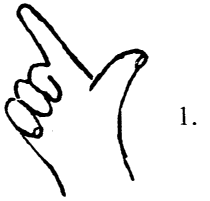
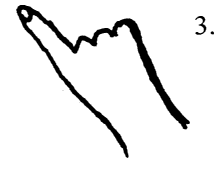
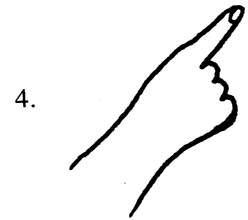

The guess is a non-verbal one indicated by means of the following hand gestures which correspond to the above positions of the bones:
After the guesser reveals his choice, the two mixers open their hands and expose the bones.
The object of the game is to guess correctly as to the location of the unmarked bones while the opponents are shifting each of the two sets. Each round has a winner and a loser and may be represented as a completed activity. However, the ordinary slahal game lasts for many rounds. The playing continues until a decisive number of rounds has been won by one side, calculated by a set of eleven wooden sticks which provide a tally of gains and losses. The teams begin with five sticks each and the eleventh stick, also known as the king stick or kick stick, is decided by means of simultaneous mixing and then guessing by a representative for each side (the guesser or pointer). The team whose pointer has guessed correctly, and sometimes after several "ties", wins possession of the kick stick. Then the bones are thrown over to the losing side and two people from this side begin to mix the bones. If the team is able to fool their opponents into guessing incorrectly, that is where the guesser has been totally wrong, the mixing side is then entitled to two sticks. They will send the bones over to the opposite side who will, in turn, start mixing — a round will have been completed. However if the guess was partially correct, that is, for example, the pointer gestured to the right and the bones were on the outside, he/she will have guessed correctly on one set of bones. This means that the guessing side only loses one stick instead of two, and the mixing side must give up one set of bones. The round then continues until the pointer guesses correctly on the set of bones which remains in play. The other alternative is that the guesser chooses correctly on the first try. Then his team loses no sticks and gains the two sets of bones and the right to mix and win sticks. The game is over when one side possesses all the tally sticks, and that may take anywhere from about fifteen minutes to many, many hours.
Wagers are placed both on the outcome of individual rounds and on the completed game. Every bet must be "covered", i.e. a like amount must be wagered by the opposite side so that winnings are provided for. All wagering is a double or nothing affair. If you bet one dollar, then you will either win two dollars (the one dollar bet plus the dollar put up by an opponent) or the dollar is lost. This wagering pattern is identical for the "round bets" and the "game bets". However "game bets" are ordinarily larger and are placed before the playing begins and recorded so that the monies may be distributed appropriately when the entire game is completed. "Round bets" are made informally by catching the eye of a person on the opposite side and moving a dollar bill or whatever you wish to bet. Both parties, then, usually crumple up the money and throw it in the center. The winner will pick up his money along with that of the other person. "Game bets" are accumulated and placed in a scarf or similar receptacle (sometimes as much as a thousand dollars or more) which is left conspicuously in the playing area throughout the game.
Slahal has been traced to aboriginal times when it served as a type of inter-village competition using blankets and other goods instead of dollars. It is interesting to note that the use of hand gestures instead of verbal guesses made it possible for groups who could not otherwise communicate to play against one another. It was also a way to enjoy yourself in the company of others while trying to keep your mind off the long, cold winter nights. Nowadays, it is common for the members of one locality to oppose those from another. For example, at Cultus Lake, B.C. the Americans (Lummi, Nooksack, LaConner) were playing the Canadians (Cowichan, Musqueam, Saanich), although at the Lummi Reserve in Washington several weeks later, some of the players who had been on the same side were now playing opposite one another. It is quite common to put your money on a player reputed to be a good pointer regardless of the side on which he or she is playing. Certain individuals are said to possess luck and power and/or expertise just as entire groups have gained similar reputations. For example, the Vancouver Island people were said to have "never been beaten" (the situation between 1910 and 1930 according to Mr. Louis Miranda). Even now, the people from Duncan are very active gamblers. There are many players known as professional who travel the circuits all year round and earn a living in this way. The professionals, then, may attract players to their respective sides with tacit promises of victory. Some frequent players are even known for their sleight of hand and special caution may accompany the guesser's choice of location of bones when these individuals are mixing them.
Slahal is perhaps the most common traditional game played on the North Pacific Coast, and music forms an essential part of it. Even games with small numbers of participants include singing and percussion. Only one side sings at any time — the side mixing the bones. Conversely when the round is over and the bones are in the possession of the opposite team, it becomes their turn to mix and sing. One objective of the mixing and singing side is to confuse and perhaps rile the opposite team — particularly the guesser who is trying to concentrate on the whereabouts of the unmarked bones. For example there was one old woman who intermittently shouted "/xexos/", "you're blind", at the guesser on the opposing side.
Slahal songs are mostly in duple metre. A majority of them are pentatonic although all possible inversions are used with great frequency.
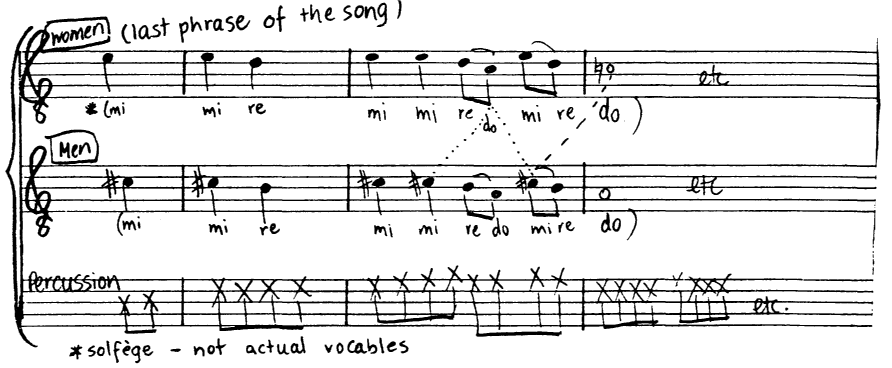

Most songs are monophonic although you often hear what appears to be parallel fourths or parallel fifths. This second voice usually consists of several women singing above the men in a range more comfortable for their voices. And although it appears that the upper part has a harmonic function, in reality the women are simply singing the identical piece a fourth or a fifth higher than the men. Frequently this produces some most interesting cross-relations as in the following example where the women are singing a third above the men:
The percussion accompaniment, 252 beats per minute on the average, includes the use of circular or octagonal deer-skin drums held at the back and beaten with a leather-ended stick. However, since many people cannot afford to buy a drum, they use the log or plank in front of them and beat with a stick. Other percussion instruments devised include two sticks together, two rocks together, a rock on a beer can, two beer cans, etc. In fact, the use of drums in slahal playing is a fairly recent occurrence and prior to 1910 or so many coastal peoples did not use them. The drums are carefully attended to and the pitch of each drum is important. It is interesting to watch how the players, one by one, approach the fire at the center to tune their drums with heat as the night wears on and the temperature drops.
The following is quite a popular song; that is, I have heard it sung many times in slightly differing versons over the course of four years:


Con tour:
Melodic
range:
Scale:
Form.
The pitch rise which occurs gradually over many repetitions is more than a semi-tone. Pitch-rise is quite a typical phenomenon explainable largely in terms of the excitement of the game. In this case, sharping occurs while sustaining the first note and pushing upward toward the second.
Descending.
Approximately one octave, although the main interest is within a fifth.
Pentatonic (from the lowest pitch — la, do, re, mi, sol, la)
A B bridge C B bridge
The next two examples are important in the way of comparison. As mentioned above there are differing versions of the same song and these examples are to elucidate that point:




As you can see, the scales of the two songs are the same. The form is almost identical (A/A/B/B! — the second example has a short bridge passage as well). However the songs are different enough, one from the other, to minimally be considered variations of each other (compare the "B" phrases).
It is rare to find two identical versions of a song even among the most popular ones. Some of the most common differences are listed here:
(1) The melody is varied, as above.
(2) The songs are often performed in different tonalities, one higher or lower than the other.
(3) The tempi are often substantially different, thus changing the character entirely.
(4) In cases where a song is rather monotonous and uninteresting, the "lead" singers try to revive the musical interest of the group, revitalizing the song and perhaps bringing more luck, spirit or power to that side. The most common device to this effect is to change a figure like into



(5) If, for example, the song uses descending sequences, the effect is often on both the length of the song as well as the melodic range. This is directly related to the absolute pitch of the starting note. If the song begins at a higher pitch, the singers can continue to add sequences, singing lower and lower while still remaining in a comfortable vocal range. The following song is a good case in point:

As to the texts of slahal songs, all of the songs in my collection consist of vocables which occur with remarkable consistency from rendition to rendition, even over the course of several years. Each slahal song seems to have definite vocables which go along with it. This might lead to the often heard speculation: perhaps the vocables were once meaningful words which evolved over years of oral tradition. In the case of slahal songs I do not think this is valid. The songs are constantly and rapidly changing. For example, Louis Miranda who has not played slahal for over 45 years recognized the songs I sang to him because he has been present at games. However he made quite clear the fact that my collection were "modern" songs and that there were many different songs used when he was playing, approximately 45-70 years ago. In other words, if the musical tradition changes so rapidly it is unlikely that a song would last for an appropriate length of time for the text to evolve into vocables. Even in the course of five seasons (1969, 1970, 1971, 1972, 1973) I saw certain changes — an affinity for a particular song, a change in melodic rhythm largely owing to the influence of one strong and respected singer, and so forth.
I have long been sceptical as to whether or not an entire song is in the mind of that individual or leader, at the time he or she initiates the song. One reason for doubt is that the leader will oftentimes hold a single note for a few seconds before proceeding, as if he/she is deciding on a song after having gained everyone's attention. An insight into this question can be seen in the following examples — three songs were recorded one after another:
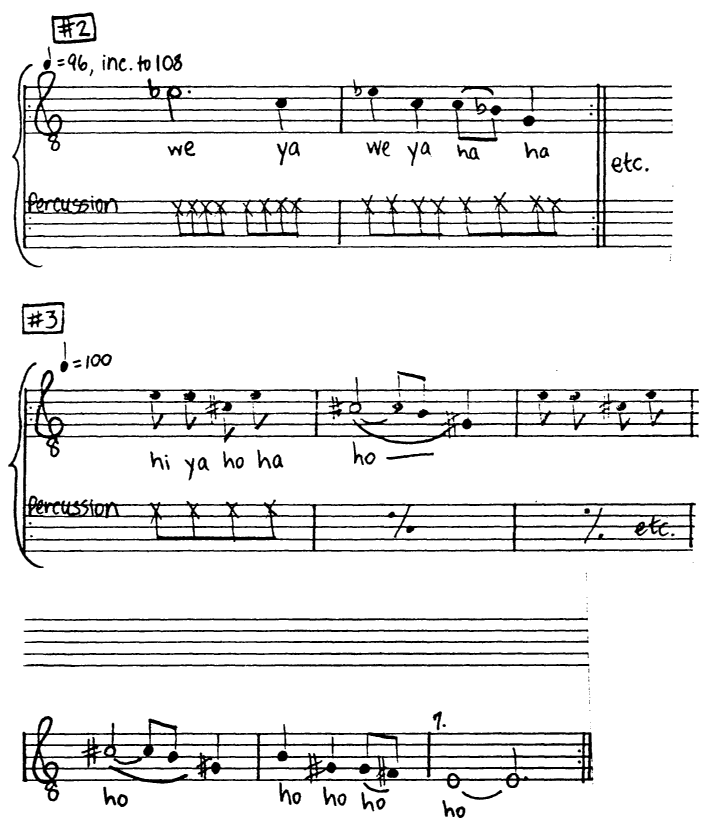
In simplified form, we have the equation No. 1 plus No. 2 equals No. 3. That is, the form and the rhythmic motives of No. 1 plus the intervals of No. 2 equals a new song, No. 3. This is an example of what might be called "instantaneous composition" as well as one manner in which new songs accrue to the repertoire.
In most circumstances a song continues until the end of a round; the length of the round determines the number of repetitions involved. In the course of these repetitions it is not difficult to learn a new song, indeed, the repetitions almost seem like a built-in mechanism for the purpose of teaching slahal songs to people who are not familiar with them. In fact, the musical tradition in slahal is transmitted almost entirely in this way. Mr. Louis Miranda, over 80 years of age and a resident of North Vancouver's Mission Reserve, has taught slahal informally to children in the North Vancouver public schools. I was fascinated to learn that he rarely used slahal melodies; rather he instructed them to yell and scream while pounding on the floor. Uncle Louie has cautioned me several times to keep things in perspective as regards slahal songs. "Slahal is only a game", he warned, and it is not essential that the songs be performed "perfectly" as is the case for spirit songs. In other words, Uncle Louie has been able to isolate music's contribution to slahal playing — a type of excitement which works on the players to produce
a powerful force. Further, I have experienced after many hours of listening, observing and singing, a certain trance-like state, perhaps because of the persistent drumbeats. I learned that it is physiologically possible to achieve a trance-like state when there are between three and seven pulses per second. On the average, slahal songs are accompanied by 252 beats per minute, or 4.3 beats per second. In other words, the musical aspects of slahal lift it from the realm of an ordinary gambling game into something far more exciting.
Slahal is played frequently among the Coast Salish for several reasons:
there is a good deal of interest in betting and the game becomes quite involving when one has put money down. There is a certain amount of fun-makirig and joking associated with playing as well as the excitement inherent in winning a game. Most important, however, is that slahal is an Indian game, played by Indians, and which stands for Indianness. In slahal we find a group of people of common ethnic identity participating in common activities — helping their teammates, feeling a sense of achievement in the monetary reward and in successful group action.
Slahal plays a part in what exists today as Indian cultural life on the North Pacific Coast. It is important in that it is a positive expression of cultural identity.
Vancouver, B.C.
Résumé: Wendy B. Stuart décrit le slahal, connu aussi sous le nom de lehal ou jeu d'osselets, un jeu de hasard Indien en honneur sur la Côte Nord du Pacifique, lequel jeu est accompagné de musique propre a intéresser les ethnomusicologues Elle met l'accent sur la musique particulière et le jeu dont la découverte a été faite parmi les peuplades de la Côte Salish en Colombie Canadienne et dans l'Etat de Washington.
© Canadian Journal for Traditional Music